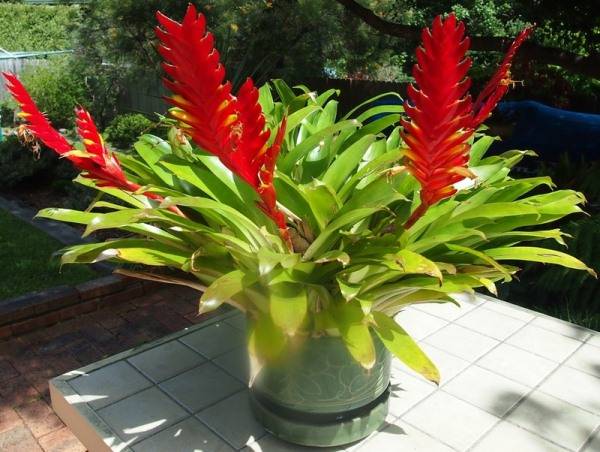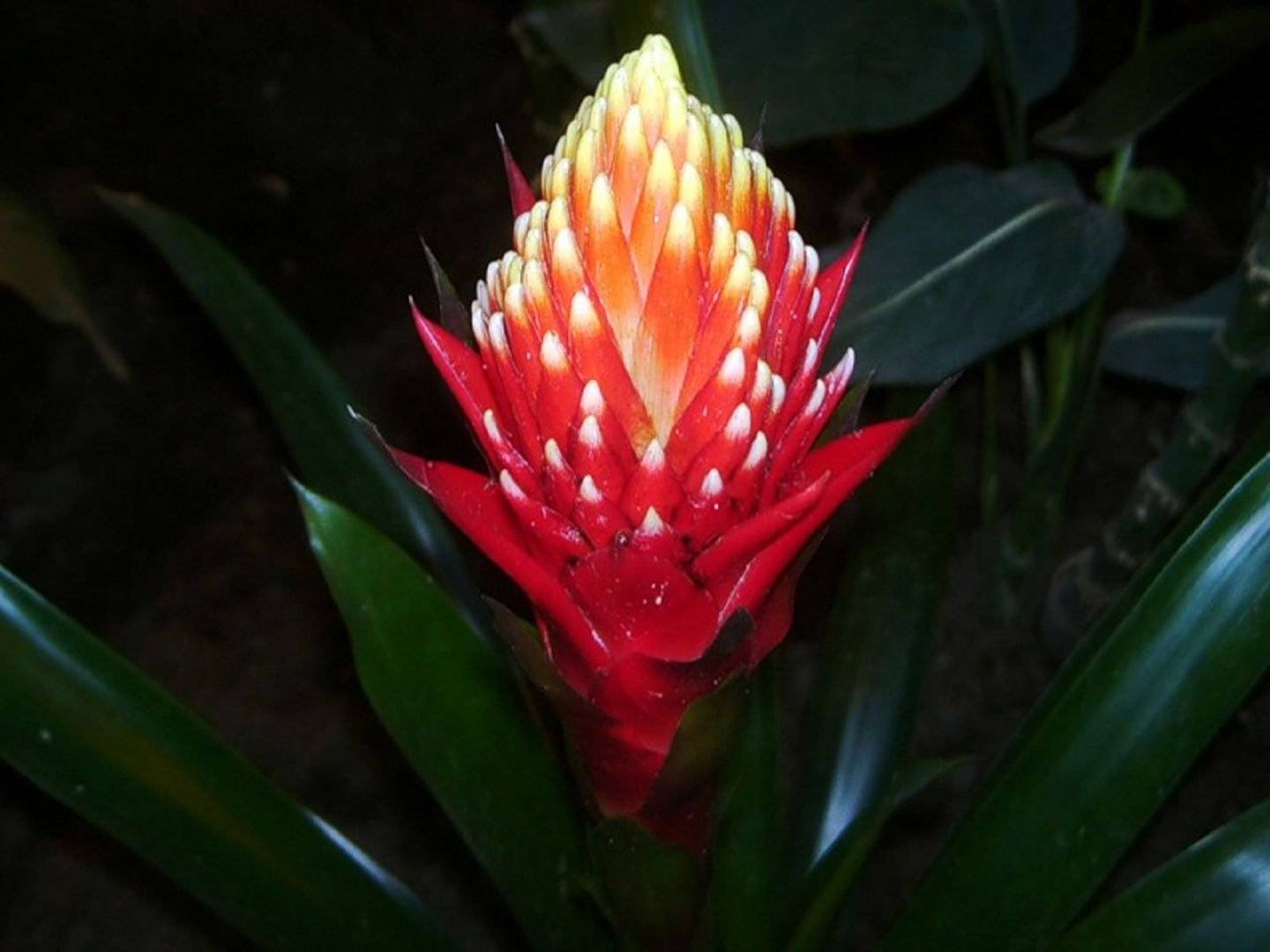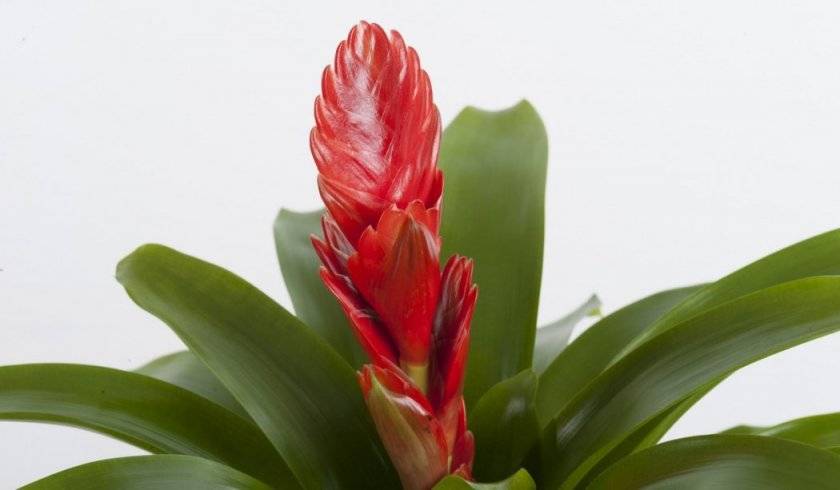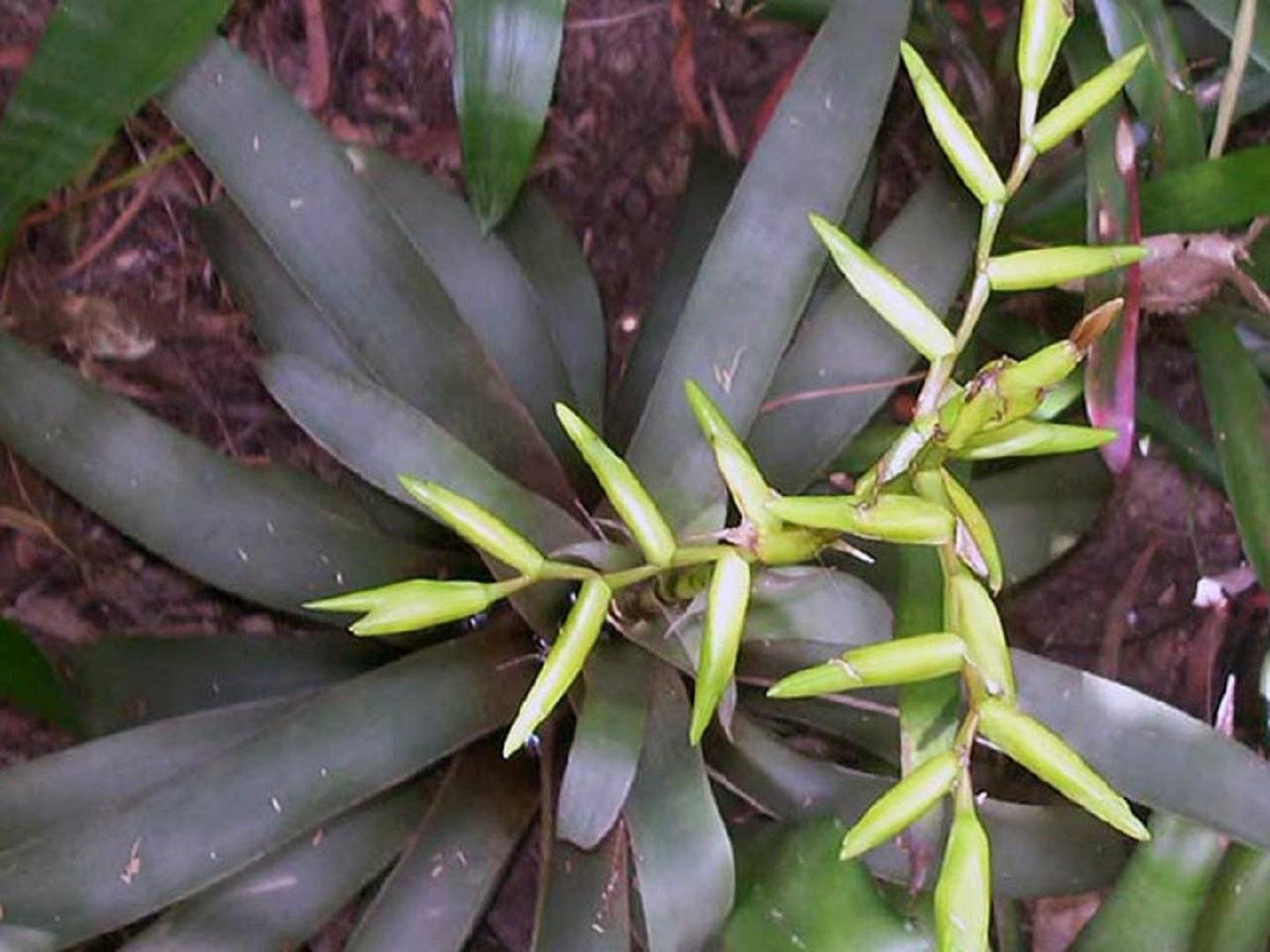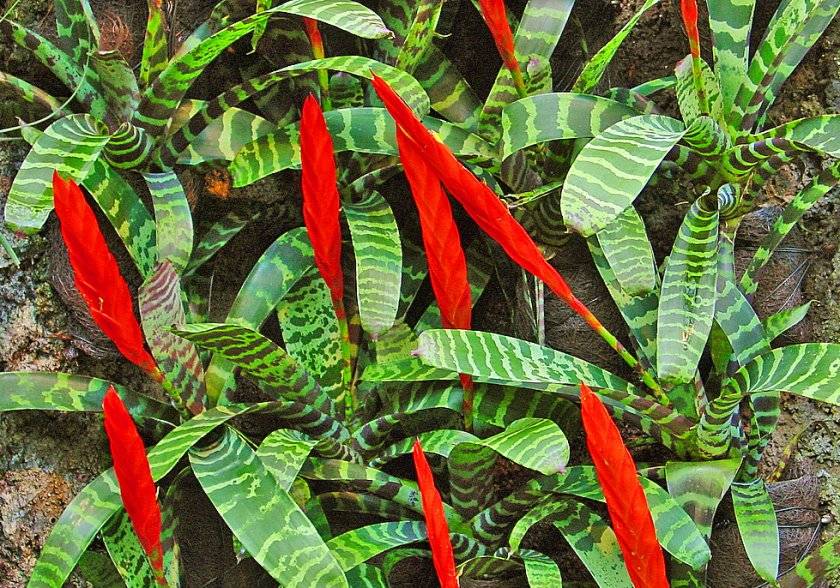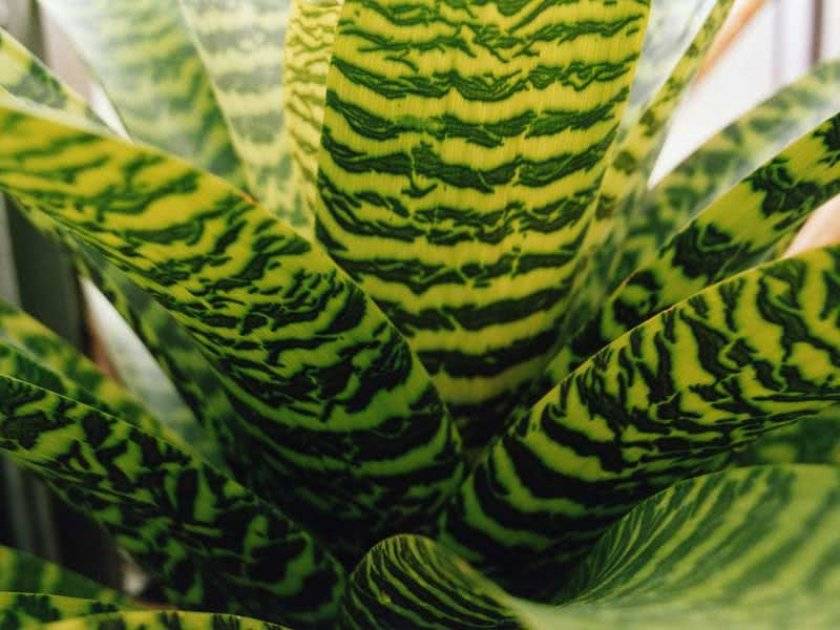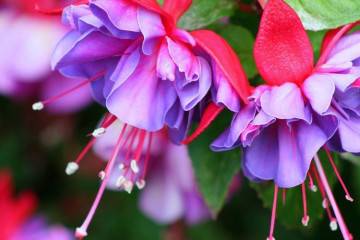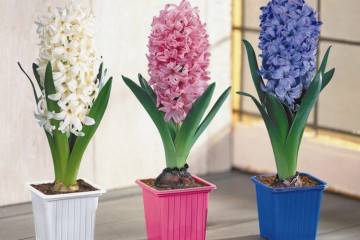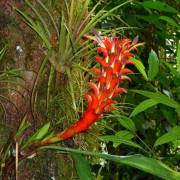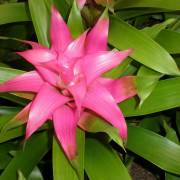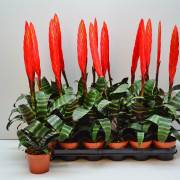Vriezia splenriet - growing and care at home
Content:
Vriezia splenriet is a unique culture that at first won the hearts of those who adhere to the feng shui system, the French kings, and now everyone who loves to grow indoor flowers. Due to its decorative properties and ease of maintenance, it is suitable for decorating offices and other business premises. And the bright flower of this plant, which blooms all year round, is able to dispel sadness and melancholy even on the darkest day.
What does it look like
The home ornamental plant Vriesia belongs to the Bromeliad family. Due to its decorative properties and unpretentious care, it earned special respect in its time in Versailles, where several varieties were bred. Today, this flower is most often used to decorate the bedroom, as it is believed to give masculine strength. Experts advise to pay attention to this interesting flora object for those who often “hover in the clouds” - the vriezia flower will help to focus on more practical aspects of life.
The plant came to Europe from the American continent. Here it is known as an epiphyte that grows in the forests of Central and South America. In total, there are more than 250 varieties of it in the world, and only half of them are known as domestic crops.
Two types have gained particular popularity among florists - vriezia splenriet and brilliant vriezia. They are most adapted to domestic cultivation and are hybrid forms of this crop.
The plant has long, pointed leaves collected in a basal rosette. Their height can reach 50 cm. The color of the leaves is olive green with light green transverse stripes.
Culture blooms all year round. After flowering, the peduncle completely dies, but before that the vriezia has time to release a new shoot. The flower is rich orange or red, reminiscent of a firebird's feather.
Vriezia - home care
Vriezia is also valuable as a home culture because it does not require special care.
Temperature
This culture is extremely fond of warmth. It is grown exclusively in room conditions with an air temperature of at least 18-20 ° C. When caring for her, it is worth placing the pot in such a place so that the vriezia does not suffer from drafts. Otherwise, the plant may die. She also does not like temperature changes.
Lighting
In winter, you should provide as much sunlight as possible for the vriezia by exposing it to a sunny windowsill. In the summer, you can put the flowerpot in the shade.
Watering
Vriezia is a moisture-loving culture. Therefore, you need to take care of regular watering. In winter, it will be enough to do this once every three days, and in summer every other day. When watering, water can be poured not only into the soil under the plant, but also the root outlet - this will be useful for the development of the flower. Watering is carried out with thawed, settled or rainwater. It is unacceptable to water a houseplant with water containing chlorine.
Spraying
Spraying is carried out in the summer months in particularly hot weather. It is enough to carry out this procedure once a week.
Humidity
Vriezia splenriet likes to grow in humid conditions. This is difficult to achieve, especially in apartments that use district heating, which dries up the air. Therefore, the plant needs to be sprayed from time to time. It is important in this case that water does not fall on the inflorescences.
The soil
For growing Vriezia splenriet at home, soils with a lightweight structure and high drainage are suitable. You can prepare potting mix for this crop. To do this, take 2 parts of ordinary soil, charcoal and sand - one part at a time.
Top dressing
You need to nourish the flower in the warm season at least once every two weeks. For this, liquid fertilizers are used for flowering indoor plants. When diluting fertilizers in water, you need to adhere exactly to the proportions so as not to damage the plant. The diluted fertilizers are poured so that they fall into the root outlet, and not into the soil, since the Vriese root system does not participate in the supply of nutrients. Among the variety of fertilizers for indoor plants, you should choose those that do not contain nitrogen and calcium.
Vriezia Era outdoors
Some species can be difficult to adapt to indoor conditions. In countries with warm climates, Vriezia Era is grown outdoors.
In areas where a continental temperate climate prevails, vriezia, the cultivation and care of which require special conditions, can survive only in the presence of a greenhouse or greenhouse.
Transfer
This flower is interesting because it suffers greatly from transplantation. Therefore, it is advisable not to carry out this procedure. But when there is a need - Vriezia needs a transplant after flowering, then this should be done in the spring, as carefully as possible so as not to damage the roots of the plant. With the slightest damage, the vriezia can die. When planting it in the ground, care should be taken not to cover the socket with earth. Otherwise, it will begin to rot and it will no longer be possible to save the plant.
When it blooms
In nature, it blooms all year round. Indoor vriezia flower can bloom for almost six months. Then, to replace it, the vriezia splenriet releases a new flower. The old flower dies off, and the new one begins to bloom.
How does it multiply
Reproduction of Vriezia can occur either from seeds or vegetatively.
Seed propagation
Growing Vriezia from seeds is a long and laborious process. And it is not a fact that it will end with the germination of a plant. It is almost impossible to buy seeds from sellers. Breeders are mainly engaged in growing this plant at home from seeds.
In this case, you should adhere to the basic rules:
- Cultivation of vriezia from seeds and care at home should take place at a temperature not lower than 21-22 ° C. Keep the seed container out of direct sunlight.
- For cultivation, a soil mixture with a light structure is chosen, best of all based on sphagnum.
- During germination, make sure that the soil does not dry out.
The first shoots appear four months after sowing the seeds. After six months, the plant can be transplanted into a large container or pot.
Vegetative propagation
Breeding by offspring is the most effective way of breeding Vriezia at home. To do this, when offspring appear on the plant, they must be carefully pinched off and placed in separate pots each for further germination.
You can create a greenhouse effect for them - covering them with plastic wrap or glass. But at the same time, one must not forget to often ventilate the plants. As soon as the sprouts get stronger, the coating is removed, and they are cared for as for adult plants.
How to determine that the babies can already be separated from the main plant and planted in a separate container? This is not difficult - the baby should be at least 1/3 of the size of the mother plant in size. At this time, the root system is actively forming and the young plant is ready for independent life.
Possible problems
Among the main problems in growing and caring for Vrieseia are the inability of the plant to bloom and the presence of pests.
Why Vriezia does not bloom
Vriezia splenriet sometimes cannot form inflorescences for a long time. This problem can be solved by using a low concentration of ethylene. To do this, take a bunch of bananas and tie them together with the plant in a plastic bag for several hours.
Pests
Among the main pests of culture should be called the scale insect of various species, as well as the red spider mite and the worm. They cause tremendous damage to the leaves and root system. One of the simple and effective means of dealing with these pests is a soap solution. You can also use special preparations, following the instructions.
Common varieties
About 130 varieties are grown under indoor conditions. They can be classified by leaf type - plants with solid or striped leaves.
With plain leaves
Royal
This is a real giant that grows in tropical forests. The height of the leaves reaches 1 meter. Therefore, it is impossible to grow it in an apartment. A greenhouse is best suited for plant growth and development. The flower of the royal vriezia is red in color, resembles a broomstick.
Mix
Vriezia mix is especially loved by florists due to the variety of bright colors of flowers - from hot yellow to deep red. This plant resembles a bouquet and is perfect for a gift for the spring holidays, given the fact that it begins to bloom just in the spring.
With striped leaves
Sanders
This variety will decorate any home. Large leaves form a rich bush. The flower is bright yellow, has a twig structure.
Shiny (lovely)
This variety is characterized by large leaves of a rich green color with transverse light green stripes, as well as a spikelet flower that reaches a height of 70 cm. An interesting feature of this species is that only the Vriezia flower can smell shiny.
Giant (mosaic, chess)
An interesting feature of this variety is the presence of white mosaic-type spots on bright green leaves. They seem to create a kind of mysterious pattern and thereby enhance the decorative properties of the plant.
There are two types of Splendens Viesia - the Beautiful and the Big Beautiful. Both of these species are similar in morphological characteristics, differing only in the size of the leaves and flowers.
The decorative properties of Vriezia allow it to be used to decorate residential and business premises. The variety of species of this plant will help create real coziness in the house. An original solution would be to decorate a small path from vases with vriezia in the corridor - bright yellow and red flowers will immediately revive the atmosphere of even a very gloomy area of the house.

